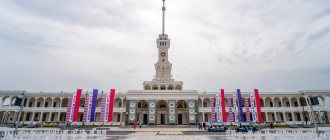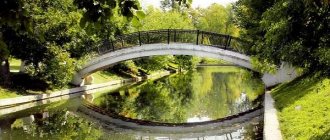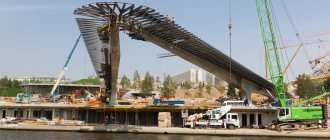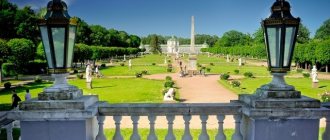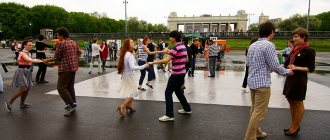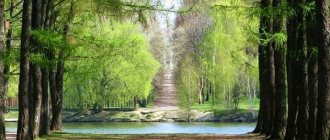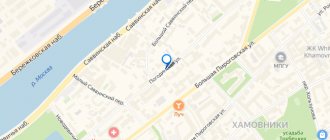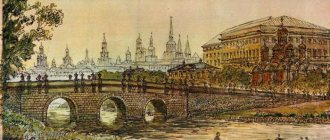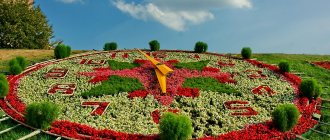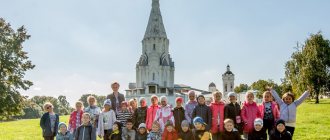The oldest and very beautiful and picturesque park in Moscow, left over from the Neskuchnoye estate. Although to this day there is still debate about the origin of such an interesting name. The park is a monument to garden and park art. It is protected by the state along with the Sparrow Hills, which once again proves the value of this cultural site.
Ideal for romantic meetings, for lovers of a relaxing holiday, as it is a very quiet and cozy place. Here you can relax your soul, sit on a bench, and enjoy the singing of birds. It is also in this park that the famous game “What? Where? When?".
Address: Moscow, Leninsky Prospekt, 30.
Opening hours: 24 hours a day.
Park type
Neskuchny Garden is very popular in the capital. Without exaggeration, all Muscovites know how to get there, and there are many guidebooks for guests of the capital. The network provides detailed routes for any type of transport.
By its type, Neskuchny Garden is a landscape park. Urban forests designed in this direction are also called English, landscape or irregular. Nearby on the right bank of the Moscow River are the Vorobyovy Gory reserve and the central part of the park named after. Gorky, with which Neskuchny Garden forms a common natural complex.
One of a kind
How good he was can be judged at least from the canvas by A. Ya. Golovin, painted in 1910. Neskuchny Garden has become a favorite place for Muscovites. How to get to it also worried many people because an incredibly popular open-air summer theater was built here. Major foreign masters of instrumental music, gypsy ensembles, and various illusionists also performed there. People came here in droves. The Soviet period also added charm to the garden - the Shrub and Industrial Exhibition was held here in 1923, the best architects of that time, V. A. Shchusev and A. V. Kuznetsov, worked on the design of the pavilions. Thus, the “Makhorka” pavilion by I. V. Zheltovsky entered the history of Soviet architecture.
Present tense
Nowadays, Neskuchny Garden is a historical part of Gorky Park. Reviews indicate that the most favorite place among vacationers is the Moskva River embankment, which acts as the border of the garden.
More recently, the park began a new stage of life that meets modern trends. Bicycle rentals are now in great demand here. You can also play table tennis, go to a large tennis court or other sports grounds, or just sit in a cafe or restaurant. They also opened a coworking space and even a mini-hotel where you can stay overnight. There were many playgrounds for children in the park.
From time to time there is information that entrance to the Neskuchny Garden is paid. In fact, visiting has always been and remains free. In addition, it works around the clock. In 2021, as always, the park is hosting many educational, cultural, sports and entertainment events. All events in Neskuchny Garden are announced on the website of the Central Park of Culture and Culture named after. Gorky. Excursions are also regularly held here.
Sometimes residents and guests of the capital have a reason to visit the Neskuchny Garden at night. In summer, open-air music festivals are held. On such days, the sound of instruments and singing do not stop until dawn.
One of the ponds in Neskuchny Garden, ©
Nearest metro stops
The Neskuchny Garden contains interesting objects from several eras. How to get to its ancient protected corners? The nearest metro station is Leninsky Prospekt, a little further is Oktyabrskaya. The area is located between Leninsky Prospekt and the Pushkinskaya embankment of the Moscow River, across which the Andreevsky pedestrian bridge leading to Neskuchny Garden is thrown into the park. The metro is within walking distance, and the entrance to the park closest to the Leninsky Prospekt station is located near house No. 30, located along this highway. The main entrance to the park is located at house No. 18. You can also walk along Pushkinskaya Embankment to Neskuchny Garden. From the Frunzenskaya station, you can reach the park in 10 minutes via the aforementioned Andreevsky Bridge.
How to get to Neskuchny Garden (Moscow)?
Neskuchny Garden is located in the central district of Moscow, the Yakimanka district. It is located between Leninsky Prospekt and the Moscow River (Pushkinskaya Embankment), between Vorobyovy Gory Park (the border runs along the Third Transport Ring) and the Central Park of Culture and Leisure named after. Gorky (the border runs along Titovsky Proezd). For some reason, there are no information signs for “Neskuchny Sad”.
By car
You can enter Neskuchny Garden from Leninsky Prospekt almost everywhere, in the area from building 18 to building 30 (located near the Third Transport Ring). Accordingly, you can leave your car where you find free space on this entire section of Leninsky Prospekt. There is quite a large free parking lot at house 30.
Another parking place is on Leninsky Prospekt near Titovsky Proezd (immediately after building 8k13 on Leninsky Prospekt or on the other side of Leninsky Prospekt near houses 15 and 15a). Through Titovsky Proezd you can enter Neskuchny Garden (located on the left along Titovsky Proezd).
You can also drive to Andreevskaya Embankment (to the intersection with Pushkinskaya Embankment), but there are often a lot of cars there. To get there, you need to turn from the Third Transport Ring onto Kosygina Street, and then take the first turn to the right, onto a small street (near building 32 on Leninsky Prospekt), which leads first along Gagarinskaya Square and then down to the embankment.
Metro
The nearest metro station is Leninsky Prospekt or Ploshchad Gagarina station on the MCC. The closest entrance from these stations is at house number 30 on Leninsky Prospekt (near Gagarinskaya Square).
From the Leninsky Prospekt metro station there is another way to the embankment - go towards Gagarin Square and cross the underground passage straight and all the way to the other side of the square. In front of you you see house 32 (Leninsky Prospekt). Go around it on the right and move towards the river. On the left you will see “Golden Brains” (the building of the USSR Academy of Sciences). Continue straight ahead (Golden Brains remain on the left). Having reached the river view, there will be a descent to the embankment on the right and left. Before descending, pay attention to the observation deck - there is a beautiful view from here. Going down to the embankment, on the left is Vorobyovy Gory, and on the right is Neskuchny Garden.
You can also get to Neskuchny Garden from the metro stations:
“Sparrow Hills” - walk along Andreevskaya embankment (along the Sparrow Hills), to Pushkinskaya embankment (here the Neskuchny Garden begins).
“Oktyabrskaya” - drive or walk along Leninsky Prospekt to the main entrance at building 18 (distance about 1.5 km).
— enter the main entrance of the Central Park of Culture and Leisure named after. Gorky (from the Krymsky Val) and walk through the park to Pushkinskaya Embankment (the beginning of Neskuchny Garden).
— move along Lenisky Prospekt towards the Moscow Ring Road to Titovsky Proezd (located on the right, 300 meters from the metro). Turn onto Titovsky Proezd and go down it to Neskuchny Garden (Neskuchny Garden will be on the left, and Gorky Park on the right).
“Frunzenskaya” (or “Luzhniki” MCC) - walk to Frunzenskaya Embankment along 1st Frunzenskaya Street. On the right you will see a beautiful glass-covered bridge - this is the Pushkinsky Bridge. Cross this picturesque pedestrian bridge to Pushkinskaya Embankment on the other side of the river. On your left will be the Central Park of Culture and Leisure named after. Gorky, and on the right is Neskuchny Garden.
From Frunzenskaya you can go to Neskuchny Garden and across the bridge where the Third Transport Ring passes. This is the Novoandreevsky railway and road bridge - there is a pedestrian path on both sides of the bridge. When you come out to the embankment on the other side of the river, you will see Vorobyovy Gory on your right and Neskuchny Garden on your left.
By motor ship
In the garden, on Pushkinskaya embankment, there is a pier for motor ships “Green Theater”.
Neskuchny Garden in Moscow: what to see, photos
One of the most popular recreational places in Moscow, especially in the summer, is the famous Park of Culture or Gorky Park. Its logical continuation is the no less interesting Neskuchny Garden.
If Gorky Park is always crowded, there is an embankment, many cafes and entertainment for every taste, then Neskuchny Garden is a more secluded place, with lush vegetation and hilly terrain, somewhat reminiscent of a real forest in the center of Moscow, I even noticed squirrels there, running briskly through the trees.
Neskuchny Garden in Moscow
While Gorky Park is a vacation spot for young people, Neskuchny is preferred by mothers with strollers, pensioners and lovers of a relaxing holiday. Once upon a time, on the site of this garden there were three noble estates of the Trubetskoys, Golitsyns and Orlovs, which were later bought by the imperial court and united into one under the common name Neskuchnoye.
Neskuchny Garden in Moscow
You can get to Neskuchny Garden from the Frunzenskaya, Leninsky Prospekt, Shabolovskaya metro stations and through Gorky Park. I decided to take a walk from Frunzenskaya along the renovated St. Andrew's Bridge.
Andreevsky Park in Moscow
More precisely, at present this bridge is called Pushkinsky, but since during its construction some structures of the old railway Andreevsky Bridge, built in 1905, were used, the first name is also often used in relation to this engineering structure.
St. Andrew's Bridge
The covered central gallery looks quite modern, while the old turrets on the side ones have been preserved.
Bridge over river
This bridge offers stunning views of Neskuchny Garden, Pushkinskaya Embankment on one side, and the Cathedral of Christ the Savior and Gorky Park on the other.
Pushkinskaya embankment
Cathedral of Christ the Savior
We go down to the park, at the entrance to which there is a diagram. The first thing we see is a small curved stone bridge.
Neskuchny Garden in Moscow
Just like the next two, it was built in the 19th century. There is a romantic legend that lovers who kiss on this bridge will link their lives forever. From this place, paths diverge in different directions.
Neskuchny Garden in Moscow
One of them goes along the bottom of a ravine, above which we see further a medium and large stone bridge.
Neskuchny Garden in Moscow
Neskuchny Garden in Moscow
The latter connects the former arena with the Alexandria Palace.
Neskuchny Garden in Moscow
The arena now houses a mineralogical museum.
Neskuchny Garden in Moscow
This part of the park was acquired in the mid-18th century by the eldest son of the famous mining owner P.A. Demidov, who was passionate about botany and gardening. In 1756 he began construction of a stone house. Behind him, on the slope of the Moscow River, he ordered to lay out a park, for which he brought more than two hundred species of various plants. It was rumored that there was no such garden not only in Russia, but also abroad. 700 serfs worked for more than two years to level the relief. There were stone greenhouses built in the park, where exotic plants were grown: grapes, pineapples, peaches. Prokofy Demidov was famous for his eccentricities. So, he made up the estate’s guards to look like park sculptures, and when a visitor picked a flower or behaved inappropriately, these sculptures came to life and frightened passers-by. In 1793, the Demidov estate was bought by one of the famous Orlov brothers, Fedor, and began to arrange everything in it to his liking. After his death, since all the count’s children were illegitimate, the estate went to his niece Anna Orlova-Chesmenskaya, but due to her too young age, her father Alexei Orlov managed everything. For his daughter, he organized grand balls at the estate. Pavilions appeared in the park, including the Bath House, which has survived to this day in extremely poor condition. Now it has no roof, and the columns are surrounded by some kind of panel.
Neskuchny Garden in Moscow
Near this pavilion there is an artificial pond, and a grotto has been preserved on the hill.
Neskuchny Garden in Moscow
Neskuchny Garden in Moscow
Also, the summer house of Count Orlov, built at the beginning of the 19th century, has survived to this day.
House of Count Orlov
Near it there is a cozy little park with benches, and there is also a poultry house.
Neskuchny Garden in Moscow
And this is what this building looks like from the side of Frunzenskaya Embankment.
Neskuchny Garden in Moscow
In honor of the coronation of Emperor Nicholas I in Neskuchny, Countess Orlova gave a grand ball, which attracted more than 1,200 guests. Perhaps it was then that the imperial family decided to purchase this estate. In 1832, the Countess sold Neskuchnoye to the Tsar, who set up a summer residence here for his wife Alexandra Feodorovna. After her seventh birth, doctors forbade her to give birth in the future, so her close relationship with her husband ended there. They say that Nicholas I specially bought this estate in order to send his wife there, and to freely meet his favorites in St. Petersburg. In honor of Alexandra Fedorovna, the palace in Neskuchny was named Aleksandiysky. In addition, the emperor acquired the neighboring estate of Moscow Governor-General D.V. Golitsyn, and the estate of Prince L.A. Shakhovsky, which previously belonged to Trubetskoy. It was under Prince Trubetskoy at the beginning of the 18th century that this property began to be called Neskuchny. The fact is that the owner of the estate entertained his guests with musical evenings, masquerades and fireworks. This tradition was revived again under Alexandra Fedorovna - an open-air theater was organized in the estate. Bushes and trees served as backstage; there was no stage as such. At first, the new entertainment attracted the public, but such a theater also had its drawbacks: due to the wind, not all words could be heard well, and in the rain the performance became completely impossible. From the Trubetskoy estate, only the Hunting Lodge has survived, in which today the program “What, where, when?” is filmed. Unfortunately, during my walk, regular filming was taking place, the house was fenced off, and the area in front of it was filled with cars.
In 1923, the First All-Russian Agricultural Exhibition was organized in Neskuchny Garden. And in 1951, after the celebration of the 800th anniversary of the founding of Moscow, a park was laid out in the park and a white-stone rotunda gazebo was erected.
Neskuchny Garden in Moscow
On its bas-reliefs you can see the main stages of the history of the capital and Russia: the founding of Moscow, the Battle of Kulikovo, revolutions, civil and Patriotic war.
Neskuchny Garden in Moscow
According to legend, if you write the name of your loved one on a piece of paper and bury it next to this rotunda, the object of your dreams will definitely pay attention to you. Nearby is the Alley of Love, also popular among lovers. Thus, there are a lot of romantic places in Neskuchny Garden, quite possibly, this is facilitated by its sparseness and special atmosphere.
Neskuchny Garden in Moscow
Also, members of all sorts of informal groups such as Tolkienists like to gather in this park. It seemed to me that Neskuchny Garden is one of the most interesting and cozy places to relax in the very center of the capital.
Boring Garden
Here are the most romantic alleys and the friendliest squirrels. Neskuchny Garden is the “middle” part of the park, which is usually called historical. The founding date of Neskuchny is considered to be 1728, when Prince Nikita Yuryevich Trubetskoy purchased land on a site near the Kaluga Outpost (now Gagarin Square) from Archimandrite German of the Zaikonospassky School Monastery for 300 rubles. Initially, “a courtyard mansion with trees planted on the banks of the Moscow River” passed to Trubetskoy on a lease basis - the prince had to pay 12 rubles a year for it.
History of the estate
In fact, on the territory of modern Neskuchny Garden, park alleys and buildings that belonged to three noble estates have been preserved.
The owner of one of them was Prokofy Akinfievich Demidov, who, like his famous father, owned large mining enterprises. P.A. Demidov was known as a passionate gardener and lover of birds and bees. On the territory of the estate, he built a rich palace for himself and placed in it many cages with songbirds.
The Demidov Botanical Garden appeared on the estate in 1756 and had the shape of an amphitheater. In addition to unusual ornamental shrubs and fruit trees, one could see palm trees, exotic for Russians. And the first plants - shoots and seeds - came to the Moscow estate from the botanical garden in Solikamsk. In 1781, academician Peter Simon Pallas lived at Demidov’s estate for a whole month and, at his request, compiled a detailed catalog of trees, shrubs and herbs growing around the miner’s house.
The owner's eccentricity manifested itself in different ways. He ordered the guards of the botanical garden to be dressed in white suits and forced them to make up themselves to resemble the park sculptures. The watchmen stood motionless and “came to life” only when one of the visitors tried to break a tree branch or plucked beautiful flowers from a flowerbed. Because of this, Muscovites began to call the garden “Neskuchny”. But this is only one version of the origin of the unusual name.
Maid of Honor Corps
After Demidov’s death, Elena Nikitichna Vyazemskaya bought the land, and after her, Count Fyodor Grigorievich Orlov. Under the new owner in 1806-1808, a large arena was built on the territory of the estate.
Adjacent to the Demidov estate to the south was the estate of Prince Nikita Yuryevich Trubetskoy, who acquired these lands in 1728. In the middle of the 18th century, a beautiful two-story house appeared here. It was erected for the princely family by the architect Dmitry Vasilyevich Ukhtomsky, a famous master of the Elizabethan Baroque. The prince's descendants remodeled the estate in their own way. They built a “Versailles garden”, a menagerie and poultry house, wooden galleries and a stone grotto.
After Trubetskoy, Neskuchnoye changed several owners. Some owners tried to establish production of iron and copper products on the estate. Others, chasing profit, opened the city's first clinic with artificial mineral waters on the shores of Moscow. However, all attempts to obtain income from the estate failed. Neskuchnoye continued to be a place of mass celebrations and entertainment, and the public who came here had fun as best they could. At the beginning of the 19th century, balloon flights, which were rare in those days, were very popular.
Summer (Tea) house
At the very beginning of the reign of Emperor Nicholas I, vast lands on the right bank of Moscow were bought by the palace department in order to create a new summer royal residence here. The southern section of the lands acquired by the treasury was occupied by the former estate of N.Yu. Trubetskoy Neskuchnoe. It is believed that it gave the name to the entire palace and park ensemble built later. Nearby was the Golitsyn estate. The north of the new royal residence previously belonged to the Orlov counts and consisted of several sections. And in the center of the vast palace estate was the ancient estate of Demidov with a botanical garden well known to Muscovites.
From that moment on, the territory of Neskuchny Garden began to be developed as a single architectural and park complex. Regular parks of individual noble estates were gradually planted with new trees and shrubs and turned into landscape ones. The famous architect Evgraf Dmitrievich Tyurin magnificently decorated the two-story building of the Oryol arena and gave it a solemn appearance.
The Demidovsky Palace, or as it came to be called, the Alexandria Palace, was also remodeled in the traditions of the late Empire style and equipped with chambers for the emperor and spacious halls for receiving guests. At the same time, according to the project of E.D. Tyurin added two large buildings to the main palace - the Freylinsky and the Cavalry, as well as a small guardhouse building. A grand entrance road led from Kaluzhskaya Street to the main entrance to the palace. It originated from the beautiful gate, which was decorated with the allegorical sculpture “Abundance”.
Hunting lodge. Filming of the program “What? Where? When?"
In 1917, the royal estate was nationalized. Then Neskuchny Garden was renamed the Maxim Gorky Park of Culture and Leisure.
Year after year, many new buildings and pavilions were erected here, and the landscape was also changed - alleys were laid out, the river bank was strengthened and new plantings were made. Therefore, the modern park is very different from what it was 100 years ago.
Manage the page: Neskuchny Garden
Edit descriptions and information about services
Answer user questions and reviews
Get access to the page by sending us a request from the establishment's official email
The construction of the estate by Trubetskoy was also a kind of diplomatic move - every weekend, every holiday, especially in the summer, Trubetskoy organized receptions, balls and holidays at his estate. Only the most distinguished, rich and influential people were invited there; the guests were personally chosen by Nikita Yuryevich. Usually the number of guests ranged from 100 to 200, but sometimes this figure reached 300, 400 and even 500 people. Trubetskoy’s receptions followed a fairly “standard” program and always included dinner, card games, a “dance part,” walks through the garden and galleries, various carousels, games and entertainment.
It is thanks to N.Yu. By the middle of the 18th century, Trubetskoy Neskuchny Garden became widely known, primarily among nobles and large industrialists. Many rich, influential people buy land in these places and build their estates. As a result, in the second half of the 18th century, in a fairly small area from the Krymsky Val to the village of Vorobyovo (the modern observation deck), there were up to 15 different estates that belonged to eminent families who left their mark on the history of Neskuchny Garden, Moscow and all of Russia. The owners and territories of the estates changed quite quickly - in half a century, some estates changed 5 owners. Among the most famous inhabitants of Neskuchny, in addition to the Trubetskoys, one can name representatives of the Yaguzhinsky, Shakhovsky, Zubov, Golitsyn, Orlov, Demidov families and even the royal family of the Romanovs.
It is believed that the garden also received its name “Neskuchny” thanks to Prince Nikita Trubetskoy. At receptions, the prince paid special attention to ensuring that every guest had something to do, so that no one was bored and everyone had fun. Based on this analogy of “fun” and “not boring,” the guests began to call Trubetskoy’s estate “Neskuchnoe.” This is where the name “Neskuchny Garden” comes from. According to another version, the name “Neskuchnoye” was invented by Trubetskoy himself, to create a certain image, as if preparing guests in advance for the upcoming entertainment. This version is the most plausible, but there are other more fantastic theories.
Historically, the borders of Neskuchny were: from the south, the Andreevskaya Sloboda, which belonged to the St. Andrew’s Monastery (now on the site of the settlement there is a residential area, the conventional border can be considered a road bridge - the third transport ring), from the north - the territory of the Golitsyns, on which the Golitsyn hospital was built in 1802. After this, the conventional border of the Neskuchny Garden was the Demidov estate and the botanical garden (now the Green Theater).
Please let us know if a location is no longer current or has an inaccurate description.
Companies do better knowing that your review can impact their rating.
